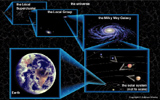- The study of the Cosmos
- The Cosmos is all that ever was and all that will ever be
- Cosmos is a Greek word meaning the Order of the Universe, it's the opposite of Chaos. - The first science
- Ancient people noticed that there were cycles in the sky and that the seasons changed with those cycles. Understanding the cycles meant being able to predict the seasons.
- Cave drawings indicate that even Crow Magnon Man was aware of the celestial cycles. - Astronomy vs. Astrology
- Astronomy literally means the knowing (or naming) of the stars
- Astrology literally means the study of the stars
- But Astronomy has become associated with the scientific study of the stars and Astrology is associated with the mystical pseudoscience that believes that the heavens can directly influence our individual lives. - Astronomy vs. Astrophysics
- Astrophysics is the application of physical law to astronomical observations in an effort to understand the workings of the Universe.
- They are basically the same thing.
- If one were to draw a difference between them, Astronomy would be more associated with the Observational aspects, and Astrophysics would be more associated with the theoretical aspects. All modern scientists that study the heavens are some mixture of Astronomer and Astrophysicist.
- The Scientific Method
- Starts with a Question
- the question may be brought on by an observation of a phenomenon
- or it may be a "I wonder what if" type question - Hypothesis
- Once the question has been well formulated as many possible explanations or answers to that question should be formulated. Some times we call these models.
- The major constraint on a hypothesis is that it must be testable. You must be able to do an experiment that could, at least in principle, disprove the hypothesis.
- Religion and Pseudoscience are not scientific because their hypotheses are not testable. They cannot be disproved.
- One should spin as many hypotheses as possible. - Experimentation/ Observation
- you must now conduct experiments or observations that will weed out your incorrect hypotheses.
- this is perhaps the most important part of the scientific process.
- Report your findings
- people make mistakes and the best way to guard against errors made in experiments is to report your findings to fellow scientists and allow them to review your work and repeat your experiments.
- The phenomenon you are studying must repeat if it is to be testable in this way. If it does not, science cannot go further with it.
- the process of peer review is one of the many error-correcting mechanisms built into the scientific method
- Draw Conclusions
- Once everyone agrees on the experimental facts and observations, the remaining hypothesis that explains your phenomenon is accepted as a working theory.
- If there are competing hypotheses that explain the data equally well, we choose the simpler one as the correct one. This is called the Principle of Occams' Razor
- Generally a theory will generate new questions and the process repeats ad infinitum.
- At many steps along the way new questions or new hypotheses might arise and the process repeats itself also.
- If at any time in the future a new fact is discovered that contradicts a theory, the theory is first modified to include the new data. If it cannot be modified or becomes too complicated with the revisions, it must be thrown out.
- Science is conservative in the acceptance of such new facts: "Extraordinary Claims Require Extraordinary Evidence" - Carl Sagan.
- Starts with a Question
- Math in science
- Math is a tool and a language.
- Some mathematicians would say that Math is the language of nature
- But physicist are much more practical. We know that it is a tool that allows us to approximate the workings of nature. The Universe is much too imperfect and sloppy for Math to do it total justice.
- But, it's the best tool we have
Our Cosmic Address:
Berkeley, California, U.S.A, North America, Western Hemisphere, Earth, Solar System, Milky Way, Local Group, Local SuperCluster, Universe, Cosmos
